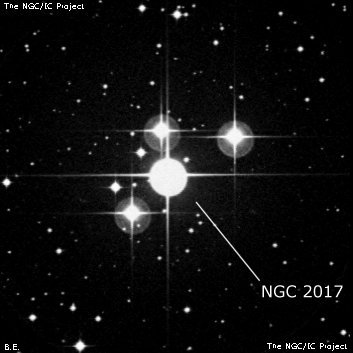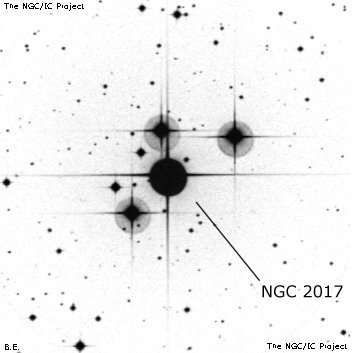NGC/IC Project Restoration Effort
(This is a very very beta version)
NGC2017


Basic Information
Location and Magnitude
Right Ascension: 5:39:16.2
Declination: -17:50:59
Constellation: LEP
Visual Magnitude:
Historic Information
Discoverer: Herschel J.
Year of discovery: 1835
Discovery aperture: 18.3
Observational
Summary description: Cl of L st
Sub-type: *Grp
Corwin's Notes
=====
NGC 2017. JH calls this "A fine clustering group of large stars" when he saw
it on 11 Dec 1835. But there are only 6 stars here brighter than V = 11.3,
four of them brighter than V = 9.0. The four would nevertheless make a
striking group at the eyepiece, and I'm a bit surprised that this asterism is
not better known.
Is it a real cluster? Probably not. One of the bright stars has a relatively
large proper motion of 67.2 milliarcseconds per year, but the other proper
motions are all six to twenty times smaller and not in any systematic
direction.
Brian Skiff comes to a slightly different conclusion; he also considers the
photometry. His discussion is at
ftp://ftp.lowell.edu/pub/bas/ocpos/n2017.pos
Whether a real cluster or not, this is worth a look now and then.
Steve's Notes
=====
NGC 2017
18" (3/13/04): multiple group of six stars mag 7-10 within 3.5'. The stars are generally separated by at least 1' with the widest separation at 2'. The brightest star is mag 6.4 HD 37643. The brightest "star" to the SE is the C+D component, a close 8.5/9.2 pair separated by 1.4", making 7 stars in total. Located 1.6¡ east of mag 2.6 Alpha Leporis.
8": this is the multiple star h3780. Six stars are visible including mag 7, 8, 8.5, 9 and 10 stars. This group does not appear to be a true cluster.



